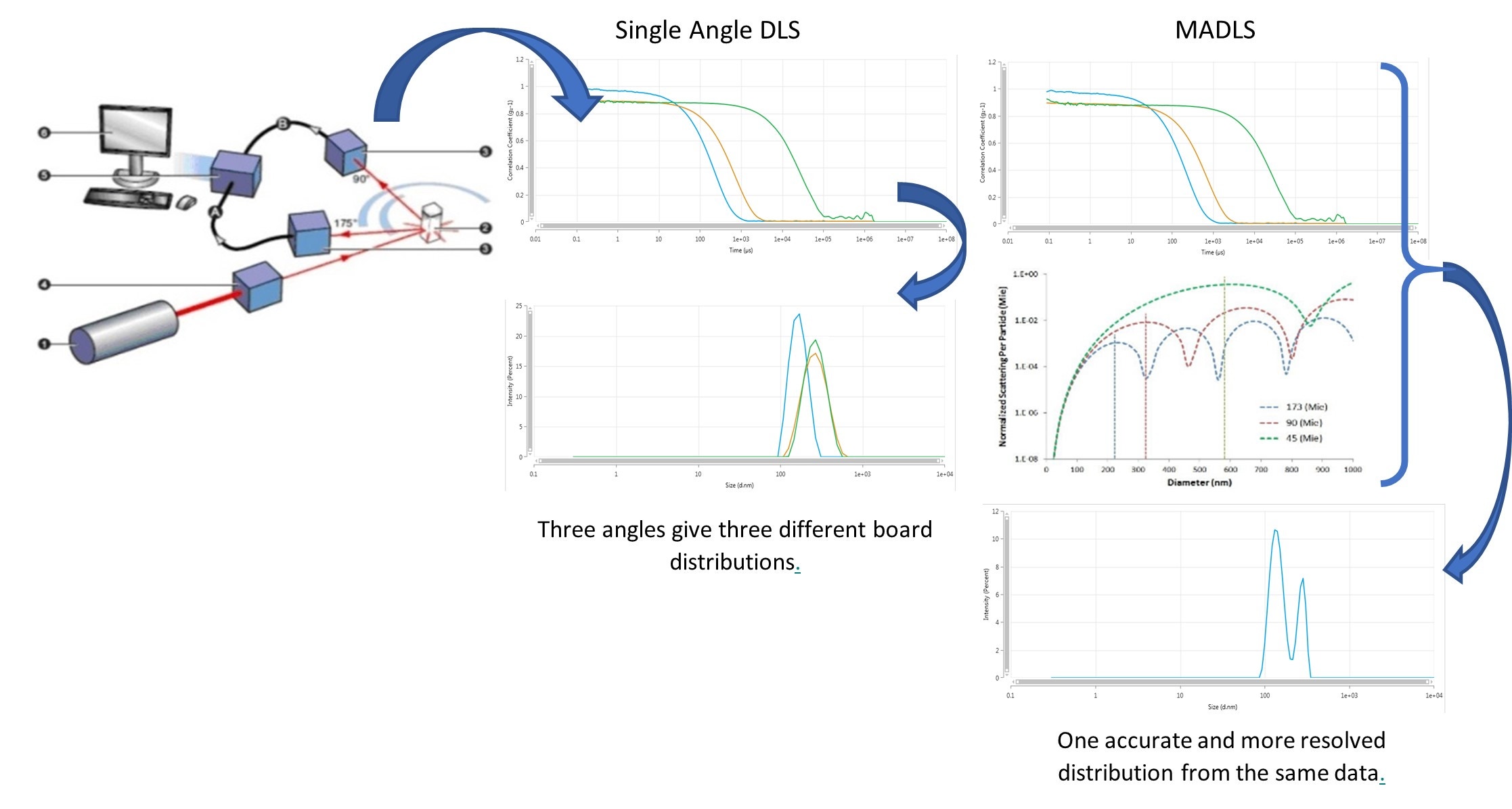Multi-angle dynamic light scattering (MADLS)
Scattering angle independent, high resolution particle size distribution

New Zetasizer Advance – DLS for every application – meet the new Zetasizer Family!. Find out more
Find out moreScattering angle independent, high resolution particle size distribution

Multi-angle dynamic light scattering, or MADLS, combines the scattering angle information from Mie theory and the particle size distribution analysis from a dynamic light scattering measurement in an integrated method. The lower noise, and hence reduced smoothing, enables a more reliable and accurate representation of the particle size distribution with improved characterization of individual components of a multi-component sample.
In a traditional dynamic light scattering (DLS) measurement, a dispersion of particles is illuminated by a coherent light source. A fraction of the light is scattered by particles within the sample. Some of this scattering is detected at a single specified angle. The fluctuations of the scattering intensity are then analyzed using a technique called autocorrelation. The size of the particles in dispersion is then derived from this autocorrelation data. This calculation uses the scattering detection angle in addition to the temperature and viscosity of the dispersant.
The intensity of light scattered by the sample depends upon the size and refractive index of the particles, and the angle at which scattering is detected - this is described by Mie theory. This means that particles of different sizes in the same sample are not all detected with the same sensitivity. A traditional single-angle DLS measurement may therefore report a different particle size distribution for a mixture, depending on the angle at which the measurement is performed. This explains why it is important to quote the scattering angle used to obtain a DLS result.
In a MADLS measurement, the correlation data from several detection angles are combined with this knowledge of Mie theory to generate a higher resolution particle size distribution. Fitting across multiple representations of the same sample also suppresses noise in the measurement, meaning a more reliable distribution can be calculated, which undergoes less smoothing and can be calculated to a higher precision than in traditional distribution analysis techniques. These improvements mean that MADLS allows improved resolution of near size components (from 3:1 to 2:1).

This high-resolution measurement also allows a number-weighted size distribution to be calculated, where the number of particles per mL is reported for each size component. This is empowered by the reduced smoothing and increased precision of the particle size, without which, calculations of particle concentration are prone to error.
Whilst MADLS particle concentration is an ensemble technique, the robust particle size distribution allows a size-resolved particle concentration without reliance on a calibration curve.
MADLS particle concentration measurements require the photon detection sensitivity of the Zetasizer Ultra to be characterized using a scattering standard, but are otherwise calibration-free.
Multi-Angle Dynamic Light Scattering (MADLS) is a powerful technique used in a wide range of applications across various industries. By measuring the scattered light at multiple angles simultaneously, MADLS provides detailed information about particle size distribution, molecular weight, and particle interactions.
Below are some key applications of MADLS technology:
MADLS is extensively used for the characterization of nanoparticles in fields such as pharmaceuticals, cosmetics, and materials science.
It enables precise measurement of particle size distribution, including submicron and nanoscale particles, essential for quality control and formulation development.


In biopharmaceutical research and development, MADLS plays a crucial role in studying protein aggregation, a common concern in protein-based therapeutics.
By analyzing the size and distribution of protein aggregates, MADLS helps researchers assess the stability and quality of biopharmaceutical products.
Polymer scientists utilize MADLS to analyze the size and molecular weight distribution of polymers.
This information is vital for understanding polymer properties such as viscosity, molecular structure, and solution behavior, contributing to the development of advanced materials for various applications.
In industries dealing with colloidal suspensions, such as paints, inks, and food products, maintaining colloidal stability is essential.
MADLS enables accurate measurement of particle size and stability, aiding in the formulation and optimization of colloidal systems to ensure product quality and shelf-life stability.



MADLS finds applications in environmental monitoring and water samples.
By assessing the size distribution of particles present in environmental samples, MADLS contributes to understanding pollution levels, assessing the impact of industrial activities, and ensuring regulatory compliance.

Zetasizer UltraThe world’s most trusted light scattering system |
|
|---|---|
| Technology | |
| Multi-Angle Dynamic Light Scattering (MADLS) | |
| Measurement type | |
| Particle size | |
| Particle concentration | |
| Zeta potential |